
Happy New Year!
Did you or your patients travel or otherwise alter your usual routines over the holidays?
If so, botanicals that support the gut microbiome might be indicated for a healthy New Year since consuming unusual foods, eating on the go, disrupted sleep, emotional stress, schedule changes, traveling, and other factors can significantly affect the health of the gut microbiome.1,2

What is a gut microbiome?
Healthy individuals have trillions of microorganisms distributed throughout the entire gastrointestinal tract, and they are collectively referred to as the gut flora or the gut microbiome. Several large research studies, including the Human Microbiome Project, have provided insight into the composition of the gut microbiome.3 We now know the gut microbiome and its metabolites play a fundamental role in many bodily functions, including nutrient production, nutrient absorption, metabolic health, immune system regulation, and the defense against infections.4
Emerging research continues to highlight how an unhealthy gut microbiome can contribute to the development of many diseases, including metabolic syndrome, obesity, diabetes, heart disease, and cancer.4 Ongoing investigations are also revealing the numerous beneficial effects a healthy gut microbiome exerts on human health.3
For example, we know the metabolites produced by the gut microbiome directly influence immune cell development and susceptibility to infectious diseases, including infections in the gut. The gut microbiome is able to affect immune function at both local and distant sites. Specifically, the bioactive metabolites from the gut microbiome, which are known as postbiotics, boost the activity of T-lymphocytes, natural killer cells, macrophages, neutrophils, and other immune cells to support a healthy immune response locally and systemically.5,6
When the gut microbiome is unhealthy or in a state of dysbiosis, it could increase the risk of developing infections since opportunistic and pathogenic organisms may flourish.7
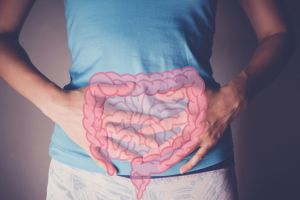
What is gut dysbiosis?
When the organisms present in the gut are not in optimal balance, it is known as gut dysbiosis. Dysbiosis has been associated with the development of acute infections and several chronic diseases, including leaky gut syndrome, obesity, heart disease, allergies, cancer, and asthma.4,8 We know holiday travel and the other factors mentioned above can increase the risk of developing gut dysbiosis and infections.1,2,9
Fortunately, several clinically effective botanicals may support a balanced and healthy gut microbiome by clearing opportunistic and pathogenic organisms.10
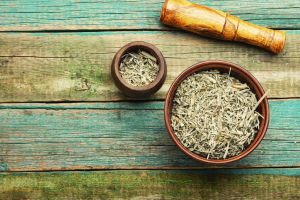
Botanicals for Balancing the Gut Microbiome
___________
Artemisia annua (Sweet Wormwood)
Artemisia annua is a botanical that has been recommended by Chinese herbalists for the treatment of many diseases since ancient times. As a Traditional Chinese Medicine, it has been recommended for tuberculosis (TB), lice, wounds, scabies, dysentery, hemorrhoids, pain and swelling around teeth, pus in the ear, nasal polyps, intermittent fevers due to malaria, heat/fever arising from exhaustion, and other health concerns.11
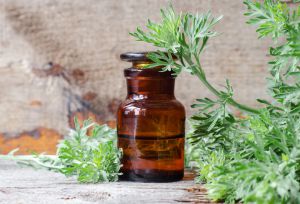
Modern research shows Artemisia annua offers inhibitory effects against several opportunistic and pathogenic organisms that could be a part of or cause harm to the gut microbiome.
These infectious organisms include:
- Parasites
- Plasmodium
- Toxoplasma gondii
- Leishmania
- Acanthamoeba
- Schistosoma
- Viruses
- Hepatitis A virus (HAV)
- Herpes simplex viruses 1 and 2 (HSV-1 and HSV-2)
- Human cytomegalovirus (CMV)
- Epstein-Barr virus (EBV)
- Human immunodeficiency virus (HIV)
- Fungi
- Candida
- Malassezia
- Saccharomyces
- Bacteria
- Enterococcus
- Streptococcus
- Staphylococcus
- Bacillus
- Listeria
- Haemophilus
- Escherichia
- Pseudomonas
- Klebsiella
- Acinetobacter
- Salmonella
- Babesia duncani
- Yersinia10,12,13
Animal studies that assessed the effects of extracts from various Artemisia species (Artemisia spp.) showed the extracts resolved gut dysbiosis. They enriched the growth of beneficial bacteria while suppressing the growth of harmful bacteria. The botanical extracts also significantly boosted carbohydrate metabolism to promote the production of healthy short-chain fatty acids (SCFAs). The Artemisia extracts also supported healthy cholesterol levels, improved glucose tolerance, protected against fatty liver disease, reduced inflammation, and prevented obesity induced by a high-fat diet.14-17
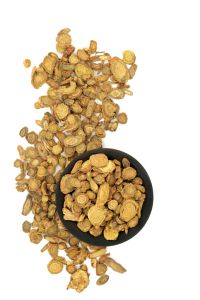
Scutellaria baicalensis (Chinese Skullcap)
Scutellaria baicalensis (Chinese Skullcap) is widely cultivated in China, Siberia, Russia, and Mongolia. Historically, the leaves of S. baicalensis were used to make a tea that reduced heat and supported detoxification. The dried root of S. baicalensis is a Traditional Chinese Medicine named Huang Qin or Huang Qi, and it has been prescribed for over 2000 years.18,19
Traditionally, Huang Qin was administered for diarrhea, high blood pressure, insomnia, and respiratory infections. S. baicalensis root contains many bioactive components, including baicalin and baicalein, which offer numerous health benefits, according to extensive research. Baicalin (BA) is a crucial flavonoid discovered approximately 60 years ago. Today, we know BA is a multi-target, multi-pathway bioflavonoid with multiple pharmacological effects, including liver-protective, anti-cancer, anti-bacterial, anti-inflammatory, antidepressant, and antioxidant benefits.18
Concerning the gut microbiome, researchers found that BA significantly inhibits the invasion of Salmonella typhimurium in a dose-dependent manner.18 In animals, BA also offers a protective effect against avian pathogenic Escherichia coli (APEC) infection by regulating the gut microbiome.20
BA markedly resolves the gut dysbiosis induced by APEC, increases the abundance of short-chain fatty acid (SCFA)-producing bacteria, and increases the production of SCFAs in the gut, including acetic acid, propionic acid, and butyric acid. The research team concluded BA may serve as an alternative antibiotic to prevent or treat APEC infections in animals in the future.20
Moreover, S. baicalensis root extracts, and the biologically active constituents therein, have shown substantial antimicrobial effects against numerous pathogens and opportunistic pathogens, including Bacillus cereus, Babesia duncani, Escherichia coli, Listeria monocytogenes, Clostridioides difficile, Salmonella anatum, Pseudomonas aeruginosa, Helicobacter pylori, Staphylococcus aureus, respiratory syncytial virus (RSV), rotavirus (RV), Aspergillus fumigatus, Candida albicans, and Rhodotorula rubra.13,19,21-25

An animal study that assessed the effects of BA on the gut microbiome determined the baicalin:
- Increased the relative abundance of Bacteroidales S24-7 by 74.7%, Bacteroidaceae by 422%, and Verrucomicrobiaceae by 10503%.
- Decreased the relative abundance of Streptococcaceae, Deferribacteraceae, and Desulfarculaceae.
- Increased the levels of beneficial SCFA-producing bacteria.
- Increased the relative abundance of Akkermansia by 10503%.26
Research shows S. baicalensis extracts may also heal dysbiosis-associated damage in the gut. Specifically, the research demonstrates S. baicalensis extract can suppress the production of pro-inflammatory cytokines and enhance the function of the intestinal barrier, thereby supporting the healing of the gut after dysbiosis or another inflammatory state.27
Clinical use and additional research studies suggest that BA exhibits therapeutic potential against several gastrointestinal disorders, including hepatic fibrosis (liver fibrosis); xenobiotic-induced liver injury; fatty liver disease; acute and chronic viral hepatitis; cholestasis; ulcerative colitis; and hepatocellular and colorectal cancers.18,28
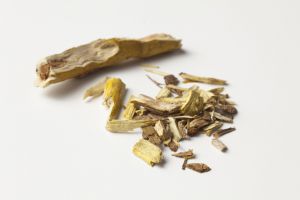
Berberine
Berberine is not a plant but an alkaloid compound found in several different plants. Berberine is present in Coptis chinensis (Chinese goldthread), Berberis aristata (Indian barberry), Berberis vulgaris (European barberry), Berberis aquifolium (also known as Mahonia aquifolium or Oregon grape holly), Berberis thunbergii (also known as Japanese barberry or red barberry), B. petiolaris, Phellodendron amurense (Amur cork tree), and other botanicals.29
Berberine-containing plant medicine has been used to treat diarrhea and other health conditions associated with the gut microbiome for more than 2000 years in Traditional Chinese Medicine. Pharmacological studies show that berberine offers broad-spectrum antimicrobial activity. Berberine has antimicrobial effects against a wide range of organisms, including fungi, bacteria, protozoans, helminths, and viruses. Research confirms berberine can reduce populations of Vibrio cholera, Shigella, Pseudomonas, Escherichia coli, Klebsiella pneumoniae, Staphylococcus aureus, Streptococcus pneumoniae, Bacillus dysenteriae, Shigella flexneri, Helicobacter pylori, C. difficile, Proteus mirabilis, and other pathogens and opportunistic pathogens in the gut microbiome.30-33
Research also indicates berberine reduces the severity of diarrhea symptoms and heals the gut microbiome by reducing inflammation, inhibiting gut motility, decreasing intestinal secretion and exudation, ameliorating impaired gastrointestinal function, relaxing intestinal smooth muscle, and prolonging the transit time of intestinal contents.30-33
Additional research shows berberine boosts the population of butyrate-producing bacteria in the gut microbiome, thus promoting the synthesis of butyrate, a nourishing short-chain fatty acid. After production by the gut microbiome, the butyrate can enter the blood to improve cholesterol levels and blood glucose (blood sugar) levels.29 Berberine also possesses antimalarial, neuro-protective, blood pressure modulating, antioxidant, anti-inflammatory, and anti-cancer properties.33

Bonus Synergistic Effects
In addition to the benefits offered by baicalin and berberine individually, combining berberine with baicalin leads to the formation of natural self-assemblies known as “BA-BBR nanoparticles (BA-BBR NPs),” which offer synergistic effects. The BA-BBR NPs promote healthy levels of brain-gut peptides, reduce inflammation, and support the beneficial organisms in the gut microbiome.34
Assessing the Health of the Gut Microbiome
To determine if you or your patients have pathogenic or opportunistic organisms in the gut microbiome, consider ordering an Expanded GI Health PanelTM with GP3x. An overview of our GI Health Panels is available HERE.
To place a test order, click here. As a reminder, DiagnosTechs will drop ship test kits directly to your patients. You may select this option at the top of the order form.
Please visit our Provider Tools page for more information about test result interpretation, treatment options, and more.
Berberine, Artemisia annua, and Scutellaria baicalensis are not intended for long-term use unless it is under the supervision of a highly-skilled physician.

References
- Matenchuk BA, Mandhane PJ, Kozyrskyj AL. Sleep, circadian rhythm, and gut microbiota. Sleep Med Rev. 2020;53:101340. doi:10.1016/j.smrv.2020.101340
- Gubert C, Kong G, Renoir T, et al. Exercise, diet and stress as modulators of gut microbiota: Implications for neurodegenerative diseases. Neurobiol Dis. 2020;134:104621. doi:10.1016/j.nbd.2019.104621
- Cresci GA, Bawden E. Gut Microbiome: What We Do and Don’t Know. Nutr Clin Pract. 2015;30(6):734-746. doi:10.1177/0884533615609899
- Gebrayel P, Nicco C, Al Khodor S, et al. Microbiota medicine: towards clinical revolution. J Transl Med. 2022;20(1):111. doi:10.1186/s12967-022-03296-9
- Varsha KK, Narisetty V, Brar KK, et al. Bioactive metabolites in functional and fermented foods and their role as immunity booster and anti-viral innate mechanisms [published online ahead of print, 2022 Jun 24]. J Food Sci Technol. 2022;1-10. doi:10.1007/s13197-022-05528-8
- Ailioaie LM, Litscher G. Probiotics, Photobiomodulation, and Disease Management: Controversies and Challenges. Int J Mol Sci. 2021;22(9):4942. doi:10.3390/ijms22094942
- Cassotta M, Forbes-Hernández TY, Calderón Iglesias R, et al. Links between Nutrition, Infectious Diseases, and Microbiota: Emerging Technologies and Opportunities for Human-Focused Research. Nutrients. 2020;12(6):1827. doi:10.3390/nu12061827
- Hufnagl K, Pali-Schöll I, Roth-Walter F, et al. Dysbiosis of the gut and lung microbiome has a role in asthma. Semin Immunopathol. 2020;42(1):75-93. doi:10.1007/s00281-019-00775-y
- Peng Y, Liang S, Poonsuk K, et al. Role of gut microbiota in travel-related acquisition of extended spectrum β-lactamase-producing Enterobacteriaceae. J Travel Med. 2021;28(3):taab022. doi:10.1093/jtm/taab022
- Wang L, Gao M, Kang G, et al. The Potential Role of Phytonutrients Flavonoids Influencing Gut Microbiota in the Prophylaxis and Treatment of Inflammatory Bowel Disease. Front Nutr. 2021;8:798038. doi:10.3389/fnut.2021.798038
- Feng X, Cao S, Qiu F, et al. Traditional application and modern pharmacological research of Artemisia annua L. Pharmacol Ther. 2020;216:107650. doi:10.1016/j.pharmthera.2020.107650
- Efferth T, Romero MR, Wolf DG, et al. The antiviral activities of artemisinin and artesunate. Clin Infect Dis. 2008;47(6):804-811. doi:10.1086/591195
- Zhang Y, Alvarez-Manzo H, Leone J, et al. Botanical Medicines Cryptolepis sanguinolenta, Artemisia annua, Scutellaria baicalensis, Polygonum cuspidatum, and Alchornea cordifolia Demonstrate Inhibitory Activity Against Babesia duncani. Front Cell Infect Microbiol. 2021;11:624745. doi:10.3389/fcimb.2021.624745
- Li J, Jin H, Yan X, et al. The anti-obesity effects exerted by different fractions of Artemisia sphaerocephala Krasch polysaccharide in diet-induced obese mice. Int J Biol Macromol. 2021;182:825-837. doi:10.1016/j.ijbiomac.2021.04.070
- Zeng X, Ren D, Li D, et al. Artemisia sphaerocephala Krasch polysaccharide promotes adipose thermogenesis and decreases obesity by shaping the gut microbiota. Food Funct. 2022;13(20):10651-10664. doi:10.1039/d2fo02257e
- Li J, Pang B, Shao D, et al. Artemisia sphaerocephala Krasch polysaccharide mediates lipid metabolism and metabolic endotoxaemia in associated with the modulation of gut microbiota in diet-induced obese mice. Int J Biol Macromol. 2020;147:1008-1017. doi:10.1016/j.ijbiomac.2019.10.069
- Zhang B , Ren D , Zhao Y , et al . Artemisia sphaerocephala Krasch polysaccharide prevents hepatic steatosis in high fructose-fed mice associated with changes in the gut microbiota. Food Funct. 2019;10(12):8137-8148. doi:10.1039/c9fo01890e
- Hu Q, Zhang W, Wu Z, et al. Baicalin and the liver-gut system: Pharmacological bases explaining its therapeutic effects. Pharmacol Res. 2021;165:105444. doi:10.1016/j.phrs.2021.105444
- Zhao Q, Chen XY, Martin C. Scutellaria baicalensis, the golden herb from the garden of Chinese medicinal plants. Sci Bull (Beijing). 2016;61(18):1391-1398. doi:10.1007/s11434-016-1136-5
- Peng LY, Shi HT, Tan YR, et al. Baicalin inhibits APEC-induced lung injury by regulating gut microbiota and SCFA production. Food Funct. 2021;12(24):12621-12633. doi:10.1039/d1fo02407h
- Chen ME, Su CH, Yang JS, et al. Baicalin, Baicalein, and Lactobacillus Rhamnosus JB3 Alleviated Helicobacter pylori Infections in Vitro and in Vivo. J Food Sci. 2018;83(12):3118-3125. doi:10.1111/1750-3841.14372
- Pellissery AJ, Vinayamohan PG, Venkitanarayanan K. In vitro antivirulence activity of baicalin against Clostridioides difficile. J Med Microbiol. 2020;69(4):631-639. doi:10.1099/jmm.0.001179
- Luo J, Dong B, Wang K, et al. Baicalin inhibits biofilm formation, attenuates the quorum sensing-controlled virulence and enhances Pseudomonas aeruginosa clearance in a mouse peritoneal implant infection model. PLoS One. 2017;12(4):e0176883. doi:10.1371/journal.pone.0176883
- Qin S, Huang X, Qu S. Baicalin Induces a Potent Innate Immune Response to Inhibit Respiratory Syncytial Virus Replication via Regulating Viral Non-Structural 1 and Matrix RNA. Front Immunol. 2022;13:907047. doi:10.3389/fimmu.2022.907047
- Shen J, Chen JJ, Zhang BM, et al. Baicalin Is Curative Against Rotavirus Damp Heat Diarrhea by Tuning Colonic Mucosal Barrier and Lung Immune Function. Dig Dis Sci. 2020;65(8):2234-2245. doi:10.1007/s10620-019-05977-w
- Zhang BW, Sun WL, Yu N, et al. Anti-diabetic effect of baicalein is associated with the modulation of gut microbiota in streptozotocin and high-fat-diet induced diabetic rats. J Funct Foods. (2018) 46:256–67. 10.1016/j.jff.2018.04.070
- Cui L, Guan X, Ding W, et al. Scutellaria baicalensis Georgi polysaccharide ameliorates DSS-induced ulcerative colitis by improving intestinal barrier function and modulating gut microbiota. Int J Biol Macromol. 2021;166:1035-1045. doi:10.1016/j.ijbiomac.2020.10.259
- Ganguly R, Gupta A, Pandey AK. Role of baicalin as a potential therapeutic agent in hepatobiliary and gastrointestinal disorders: A review. World J Gastroenterol. 2022;28(26):3047-3062. doi:10.3748/wjg.v28.i26.3047
- Zhang L, Wu X, Yang R, et al. Effects of Berberine on the Gastrointestinal Microbiota. Front Cell Infect Microbiol. 2021;10:588517. doi:10.3389/fcimb.2020.588517
- Yu M, Jin X, Liang C, et al. Berberine for diarrhea in children and adults: a systematic review and meta-analysis. Therap Adv Gastroenterol. 2020;13:1756284820961299. doi:10.1177/1756284820961299
- Chou S, Zhang S, Guo H, et al. Targeted Antimicrobial Agents as Potential Tools for Modulating the Gut Microbiome. Front Microbiol. 2022;13:879207. doi:10.3389/fmicb.2022.879207
- Wultańska D, Piotrowski M, Pituch H. The effect of berberine chloride and/or its combination with vancomycin on the growth, biofilm formation, and motility of Clostridioides difficile. Eur J Clin Microbiol Infect Dis. 2020;39(7):1391-1399. doi:10.1007/s10096-020-03857-0
- Behl T, Singh S, Sharma N, et al. Expatiating the Pharmacological and Nanotechnological Aspects of the Alkaloidal Drug Berberine: Current and Future Trends. Molecules. 2022;27(12):3705. doi:10.3390/molecules27123705
- Li L, Cui H, Li T, et al. Synergistic Effect of Berberine-Based Chinese Medicine Assembled Nanostructures on Diarrhea-Predominant Irritable Bowel Syndrome In Vivo. Front Pharmacol. 2020;11:1210. doi:10.3389/fphar.2020.01210

